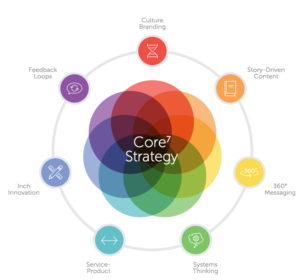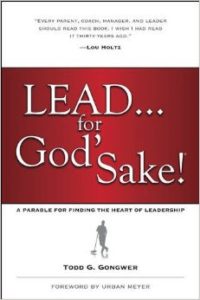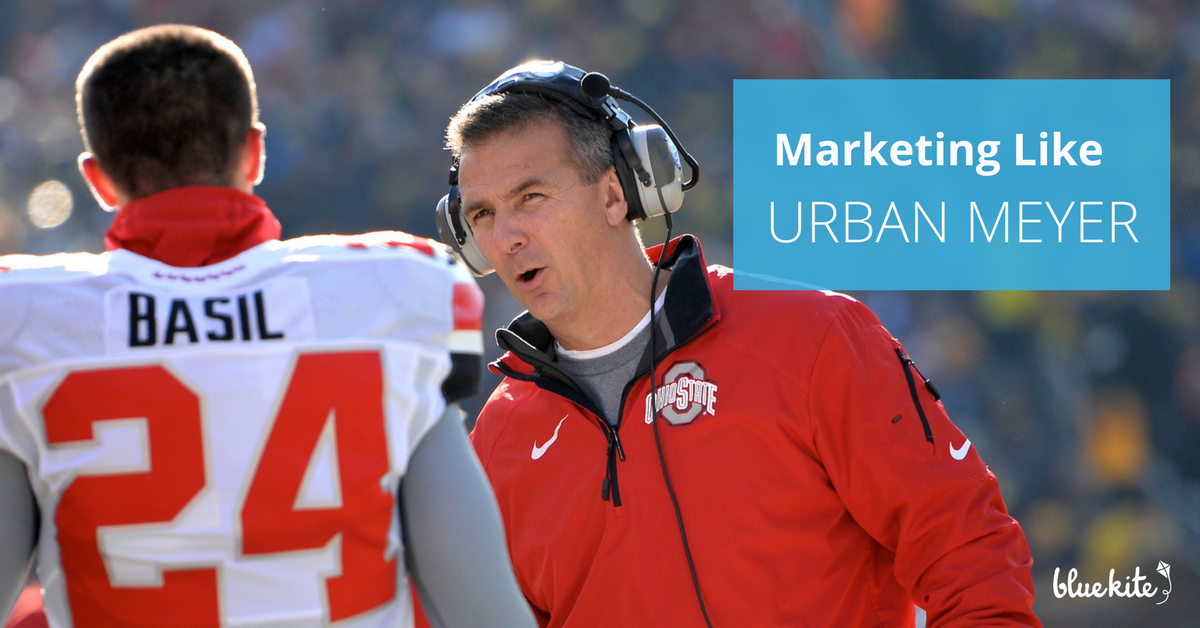Following the herd, especially the marketing herd, will get you fired.
Why? Mark Twain offers a clue:
Whenever you find yourself on the side of the majority, it is time to pause and reflect. – Mark Twain
The marketplace of ideas, especially marketing ideas, is filled with ideas already past their “effectiveness prime”. Actually, the ideas adopted by the herd are already obsolete and on the down slope of performance. You can pinpoint a bad idea by noting how many marketing pundits are talking about it. The more you hear about an idea the less likely it will work.
How do you get fresh ideas that have a fighting chance of moving the needle?
Look outside the marketing discipline for inspiration. Lately, I’ve been obsessed with high-performance college coaches including Nick Saban, Tom Herman, and my favorite Urban Meyer, coach of The Ohio State Buckeyes.
First, here are Meyer’s stats:
- 193 wins and 29 losses representing a phenomenal .855 winning percentage. Simply, if he plays you, there’s an 85% chance that you’ll lose.
- 3 National championships at two schools in just 9 years.
- The only coach in college coaching history to have four 20-game winning streaks.
Urban wins. Often. I’m obsessed with how he does it.
Here’s what I found.
A Sad Side Note: Urban Meyer and The Buckeyes lost their playoffs semifinals game to Clemson in a shut out. It was the first time since 1993 that the Buckeyes was shutout in a Bowl game. This was also the first time Urban Meyer didn’t score a point in a Bowl game. So, is Urban Meyer still a great coach and uncanny marketer?
Absolutely. Keep reading.
Core7 Applied to Urban Meyer
 First, I need to catch you up on a powerful approach called Core7. Core7 is Blue Kite’s marketing framework for aligning a company’s culture, story, and capabilities.
First, I need to catch you up on a powerful approach called Core7. Core7 is Blue Kite’s marketing framework for aligning a company’s culture, story, and capabilities.
Simply, Core7 is how we help organizations grow.
Core7 has 7 guiding principles that help marketers focus on the right areas in the right sequence.
You can learn more about Core7 here.
We’ll use Core7 as a lens to examine Urban Meyer’s tactics.
Culture Branding
What is the difference between Apple’s culture and brand?
We know that Apple’s brand is focused on changing the world by creating devices that empower its users.
Their culture embraces creativity, obsessive attention to detail, and a hard-nosed collaboration that prioritizes excellence above civility (at times).
Their culture serves their brand.
You’ll see this symbiotic culture to brand relationship play out in most of the world’s top companies.
It can also be seen in Urban Meyer’s Buckeyes.
Ohio State’s brand embraces excellence, on the field and off the field.
Every player is taught from day one that playing for The Ohio State University is a privilege and everything including their meals are earned.
Their culture reinforces the Ohio State brand. Listen to an Urban Meyer interview and you’ll likely hear two phrases:
“What I’m looking for is simplicity, 4 to 6 and A to B. If you can’t give us that, then we gotta move on and get another player that will.” – Urban Meyer
- 4-6 seconds is the time it takes to complete a football play.
Meyer wants players to focus on giving 100% during those seconds. - A-B means getting from one point to the next as fast as you can.
You don’t walk.
You don’t give a half-hearted effort.
Ohio State’s brand is strong enough to attract talented high school players. Ohio State’s culture turns those players into champions.
Story-Driven Content
One week before a game, the coaching staff produces a trailer video. The video
frames the challenge the team will face and shows how they will overcome it.
Take a look:
After the game, the team produces a highlight video and shares it on their social media channels.
Like the teaser video, the highlight reel tells the tale of the team’s triumph over the victor.
With a 12 and 1 season record, there’s a lot of videos to enjoy.
For football, the story always narrates the march to victory or the stumble to defeat.
Your story will have a different arc depending on your vision.
There are many ways to tell this story; the goal is to take the time to tell it often.
Tell the story to your customers and employees.
The story never has “You” as the hero, either your customer or your team is the hero.
Story-Driven Content only works when you are willing to share the stage.
Learn more about Story-Driven Content
360
° Messaging
Urban Meyer’s mastery of media is one of his most unrecognized talents. The coaching staff uses media to motivate their players, excite their fans, and persuade top high-school recruits. Notably, Urban Meyer uses Twitter, texting, and Facebook to stay in contact with recruits. In one press conference, when asked about social media, he mentioned that his staff is full of 50-year old guys trying to figure out Twitter.
Thank you to our parents for your support!! You’re a major part of this Football Family!! Go Bucks! pic.twitter.com/ln84DCIvI2
– Urban Meyer (@OSUCoachMeyer) December 31, 2016
He knows that to reach his audience he has to meet them where they hang out online.
360
° Messaging isn’t about using every media platform at your disposal. It’s about using the minimum number of marketing platforms you can to tell your story with impact. Did you catch that you should use the minimum number of platforms you can? That’s right, quality and focus trumps quantity and diversification. Why? Frankly few organizations can produce enough content to tell their story on dozens of platforms. On the other hand, any organization can craft quality content for one or two platforms.
Why do we call it 360
° Messaging then? We use 360
° to remind us to think beyond the traditional advertising platforms. Any screen is a potential platform for your story. Don’t let yourself get boxed in with “online”, “social”, or “traditional” advertising. Your audience dictates the platform – not the latest gee-whiz tool.
Learn more about 360
° Messaging
Systems Thinking
The real secret, says Meyer, is realizing the infallibility of the plan. If it is followed, he says, “it is a hundred percent guaranteed” to work. 1
It’s called “The Plan To Win”. Urban Meyer wrote the Plan when he got his first job as a head coach at Bowling Green University. The Plan To Win details Urban’s system for creating culture, strength training, team rules and even nutrition. Over the years, the Plan to Win has evolved but it still is implemented to the letter.
Meyer’s Plan to Win shows the power of Systems Thinking. The Buckeye head coach could “wing it” but he knows that “winging it” leads to unpredictability, and unpredictability leads to spotty results. You can’t amass 61 wins with an unsystematic approach.
Systems Thinking is the third leg of a three-legged stool with strategy and tactics. Your marketing systems should provide your team a consistent process for implementing the tactics that drive your strategy.
Effective organizations know how to quickly execute creative strategies and tactics. Speed is a competitive advantage and systems thinkers are best positioned to profit from rapid execution. Quality is another competitive advantage but
is harder to exploit. Quality execution requires an obsessive focus on detail and precision. Systems Thinking is valuable here because it gives the organization a common blueprint and a shared language for producing superior results.
Your “Plan to Win” starts with a focus on Systems Thinking. Do you have one?
Learn more about Systems Thinking
Service-Product Mindset
Urban Meyer spends time teaching other coaches his approach to growing boys into men while turning them into stellar football players. When you have 60 minutes, treat yourself to
rare glimpse inside a coaching clinic keynoted by Urban Meyer.
 He’s also turned his experience into a bestselling book “Above the Line” and endorsed books that have been pivotal to his approach such as “Lead For God’s Sake”
He’s also turned his experience into a bestselling book “Above the Line” and endorsed books that have been pivotal to his approach such as “Lead For God’s Sake”
by Todd Gongwer.
Urban Meyer isn’t just a coach he’s a teacher and motivator. He’s creatively turned his experience as a coach into a product used by coaches.
I find that having a Service-Product Mindset is the most difficult of the Core7 principles to grasp. It’s easy to get trapped by your primary product or service. However, finding ways to add a service to your product or packaging your service into a high-quality product will diversify your revenue and grow profit margin too.
Learn more about Service Product Mindset
Inch Innovation
Urban Meyer is considered to be one of the game’s most innovative football coaches. One of his innovations, the spread option offense is considered one of the most explosive offensive schemes in football. Urban’s been tinkering with his spread option turning it into a powerful tool for racking up wins and championships.
The Buckeye coaching staff, fueled by Urban’s passion, have become innovation machines. Mickey Marotti, Ohio State’s strength and conditioning coach places biometric sensors
on players to evaluate their physiological readiness to practice and play.
The coaching staff also pioneered the use of “On-Edge Teaching” that emphasizes role-playing, direct, and hands-on learning versus lecture-type teaching.
Inch Innovation is a powerful principle that often escapes notice. Leaders are trained to look for the “Wow” innovation, the swing-for-the-fences gamble that gets people on the front cover of Fortune magazine. But, the real innovation that creates enduring organizations comes from the patient but persistent innovations that incrementally push the performance needle.
You are surrounded by these valuable inch innovations. You just need to adjust your focus to find them. Start with the step-by-step processes that you haven’t touched in years. Often a small tweak there can yield big results. Next look at all of your customer touch points.
What is a small change that can perhaps accelerate your sales cycle, convince a customer to refer a friend, or prevent a customer from defecting to a competitor? How quickly can you execute a small test?
Learn more about Inch Innovation
Feedback Loops
Coach Meyer is obsessed with data. He’s also the most evaluation-focused coach in college football. Ohio State players often share that “everything” they do is tracked. Assistant coaches are required to give no-nonsense, data-driven, feedback to their players. Players aren’t coddled. They get the relevant feedback they need to succeed.
Marketers have a secret.
The cold precision of data mocks our reverence for the “Art of Marketing.” I remember Gary Vaynerchuk, a brilliant marketing thinker, shouting “What’s the ROI of your mom’s love?” when asked about the ROI of social media. His exasperation with measurement, while eloquently stated, was misplaced.
Measurement, specifically, raw feedback from your customers, constituents, or donors is valuable. We no longer need to guess about customer sentiment, if our products work, or if our marketing will motivate the right audience. Simple tests, surveys, and other feedback loop tools can give you the data you need right now.
By the way, I don’t care if you aren’t “good with math.” We live in a data-driven world, so get good at math and get real comfortable with analyzing data. Heaping praise on the “tech guy” ability to handle the number just exposes you as being dangerously unqualified to manage modern marketing campaigns.
The rant is over. Learn to love feedback loops and you’ll find your organization winning more and hoping for a miracle less.
Learn more about Feedback Loops
Transform Your Marketing Approach One Step At a Time
Core7 Strategy isn’t a strategic shopping list. You can’t pick and execute principles at random. It only works by taking each principle in sequence, starting with Culture Branding.
Get your head wrapped around the principle, then decide on the best way to implement the principle in your organization. Give us a call if you need help.
The hardest part, as with anything, is getting started.
Core7 will give you a solid blueprint for the year.
Featured image credit: MGoBlog



